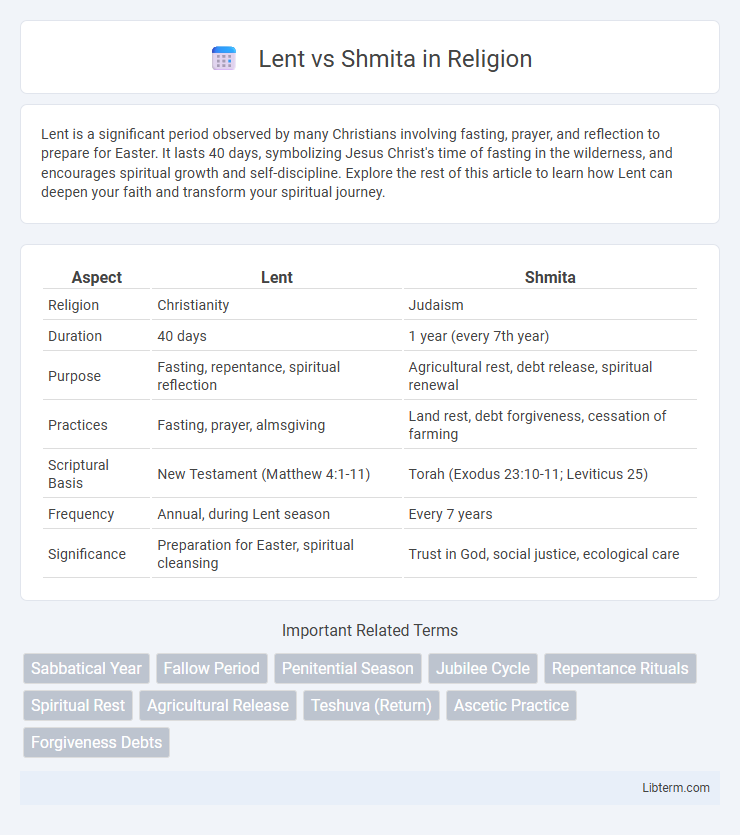Lent is a significant period observed by many Christians involving fasting, prayer, and reflection to prepare for Easter. It lasts 40 days, symbolizing Jesus Christ's time of fasting in the wilderness, and encourages spiritual growth and self-discipline. Explore the rest of this article to learn how Lent can deepen your faith and transform your spiritual journey.
Table of Comparison
| Aspect | Lent | Shmita |
|---|---|---|
| Religion | Christianity | Judaism |
| Duration | 40 days | 1 year (every 7th year) |
| Purpose | Fasting, repentance, spiritual reflection | Agricultural rest, debt release, spiritual renewal |
| Practices | Fasting, prayer, almsgiving | Land rest, debt forgiveness, cessation of farming |
| Scriptural Basis | New Testament (Matthew 4:1-11) | Torah (Exodus 23:10-11; Leviticus 25) |
| Frequency | Annual, during Lent season | Every 7 years |
| Significance | Preparation for Easter, spiritual cleansing | Trust in God, social justice, ecological care |
Introduction to Lent and Shmita
Lent is a Christian observance lasting 40 days, commemorating Jesus Christ's fasting and reflecting themes of repentance, self-discipline, and spiritual renewal leading up to Easter. Shmita, or the Sabbatical year in Jewish tradition, occurs every seventh year, mandating the resting of agricultural land to promote sustainability, social justice, and faith in divine providence. Both practices emphasize rest and renewal, but Lent centers on personal sacrifice and spiritual preparation, while Shmita focuses on communal rest and ecological balance.
Historical Origins of Lent and Shmita
Lent originates from early Christian traditions dating back to the 4th century, rooted in a 40-day period of fasting and penance before Easter to commemorate Jesus Christ's 40 days in the desert. Shmita, or the Sabbatical year, stems from ancient Israelite agricultural laws found in the Torah, specifically in Leviticus 25, mandating a year of rest for the land every seven years. Both practices reflect cycles of spiritual renewal, with Lent emerging from Christian liturgical history and Shmita grounded in Judaic legal and agricultural traditions.
Religious Significance: Christianity vs Judaism
Lent in Christianity is a 40-day period of fasting, prayer, and repentance commemorating Jesus Christ's 40 days in the desert, symbolizing spiritual purification and preparation for Easter. In Judaism, the Shmita year occurs every seven years as a sabbatical year for the land of Israel, emphasizing rest, agricultural cessation, debt forgiveness, and social justice rooted in Torah law. Both observances embody concepts of spiritual renewal and obedience to divine commandments but differ in their rituals, duration, and theological underpinnings unique to Christian and Jewish faith traditions.
Timing and Duration: Lent vs Shmita
Lent is a 40-day period observed annually in Christianity, beginning on Ash Wednesday and ending on Holy Saturday, preceding Easter Sunday. Shmita, or the Sabbatical Year, occurs every seventh year in the Jewish agricultural cycle, lasting an entire lunar year from Tishrei to Tishrei. While Lent is a short, fixed duration focused on penitence and fasting, Shmita spans a whole year emphasizing rest and land sabbath in accordance with biblical law.
Core Practices and Rituals
Lent, observed in Christianity, involves fasting, prayer, and almsgiving for 40 days to commemorate Jesus' fasting in the desert, promoting spiritual reflection and penitence. Shmita, a biblical Sabbatical year in Judaism, mandates resting the land by ceasing agricultural work every seventh year, emphasizing ecological sustainability and social justice. Both practices foster renewal, with Lent focusing on personal sacrifice and Shmita on communal restoration.
Spiritual Goals and Reflections
Lent and Shmita both serve as profound periods of spiritual reflection and renewal, with Lent emphasizing repentance, fasting, and self-denial to cultivate humility and deeper connection to God. Shmita, observed every seven years in Judaism, focuses on rest, release, and trust in divine provision by letting the land lie fallow and forgiving debts, fostering social justice and communal healing. Both traditions encourage believers to realign their lives with spiritual values, promoting inner transformation and strengthened faith.
Impact on Daily Life and Communities
Lent and Shmita profoundly shape daily routines and community dynamics through fasting, prayer, and rest cycles, fostering personal discipline and collective reflection. Lent's 40-day period encourages personal sacrifice and spiritual renewal, impacting diet and social interactions, while Shmita mandates a sabbatical year for the land every seven years, promoting environmental sustainability and economic rest for farmers. Both observances reinforce communal bonds and ethical stewardship, affecting food consumption patterns, work habits, and social support systems.
Fasting and Rest: Comparative Perspectives
Lent in Christianity involves fasting and abstinence for 40 days, promoting spiritual discipline and reflection through reduced food intake and fasting on specific days. Shmita, observed in Judaism every seventh year, emphasizes agricultural rest by prohibiting work on the land to allow it to rejuvenate, though it does not mandate personal fasting. While Lent centers on individual fasting to foster repentance and spiritual growth, Shmita focuses on communal rest and environmental sustainability through mandated cessation of agricultural activity.
Modern Observance and Adaptations
Modern observance of Lent typically involves fasting, prayer, and almsgiving over a 40-day period, reflecting themes of repentance and spiritual renewal in Christian communities worldwide. Contemporary Shmita practices emphasize sustainable agriculture, debt forgiveness, and environmental awareness every seventh year, with Israeli farmers often relying on government subsidies and community-supported agriculture to uphold traditional laws. Both observances have adapted to modern contexts by integrating social justice initiatives and environmental stewardship while maintaining core religious principles.
Key Similarities and Differences
Lent and Shmita both represent periods of spiritual reflection and renewal within their respective religious traditions--Christianity and Judaism. Lent spans 40 days of fasting, prayer, and penance leading up to Easter, emphasizing personal sacrifice and repentance, whereas Shmita occurs every seven years, mandating a Sabbath year of rest for the land, debts release, and social equity. While Lent centers on individual spiritual discipline, Shmita integrates communal agricultural practices with ethical social reforms, highlighting differing but complementary approaches to holiness and societal responsibility.
Lent Infographic

 libterm.com
libterm.com